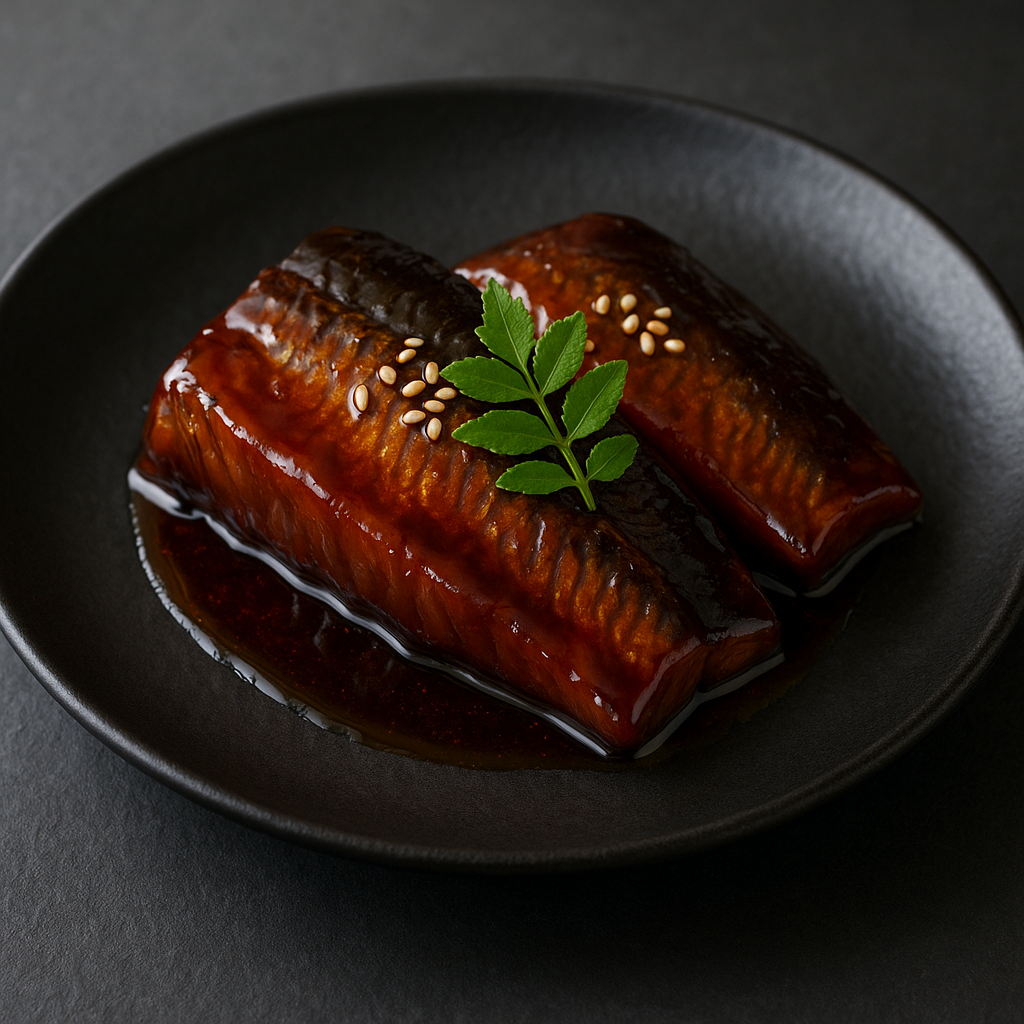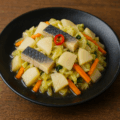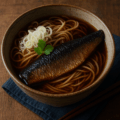身欠きニシンの甘露煮の特徴
北海道の保存食から生まれた料理
身欠きニシンの甘露煮は、乾燥させた身欠きニシンを甘辛い煮汁で柔らかく煮込んだ北海道の郷土料理です。保存性が高く、噛むほどに旨味が広がります。
骨まで柔らかい仕上がり
じっくりと煮込むことで骨まで柔らかくなり、丸ごと食べられるのが特徴です。カルシウム補給にも優れています。
ご飯にも酒にも合う味わい
濃いめの甘辛い味付けがご飯のおかずや酒の肴にぴったりで、保存食としても重宝されています。
身欠きニシンの甘露煮のレシピ
材料(4人分)
- 身欠きニシン(乾燥) … 4本
- 醤油 … 80ml
- みりん … 60ml
- 酒 … 60ml
- 砂糖 … 大さじ2
- 生姜(薄切り) … 数枚
- だし汁 … 200ml
作り方
- 身欠きニシンは水またはぬるま湯に数時間浸けて戻す。
- 戻したニシンを食べやすい大きさに切る。
- 鍋にだし汁・醤油・みりん・酒・砂糖・生姜を入れて煮立てる。
- ニシンを加え、落し蓋をして弱火で1時間ほど煮る。
- 煮汁が少なくなり、照りが出てきたら完成。
シェフのワンポイントアドバイス
時間をかけてじっくり煮ることで骨まで柔らかく仕上がります。個体差があるので、骨の具合を見ながら加熱してください。
冷蔵庫で一晩置くと味がより染み込み、美味しさが増します。
身欠きニシンの甘露煮の栄養価(1人分の目安)
- エネルギー:約200〜250 kcal
- たんぱく質:20〜25 g
- 脂質:5〜8 g
- 炭水化物:10〜15 g(調味料由来)
- カルシウム(骨由来)
- ビタミンD・B群(魚由来)
- EPA・DHA(魚由来)
高たんぱくでミネラルも豊富なため、健康的な保存食として重宝されます。
身欠きニシンの甘露煮の歴史
保存食としての活用
身欠きニシンは、北海道から本州へと大量に出荷された保存食で、古くから家庭料理や交易品として重宝されてきました。
郷土料理への発展
保存のための乾物を、甘露煮にすることで日常的に食べやすく工夫されました。特に冬の保存食として定着しました。
現代の身欠きニシン
現在ではおせち料理や郷土料理店の定番メニューとして提供され、北海道を代表する伝統料理のひとつとなっています。
English Version
Features of Simmered Dried Herring (Mikaki Nishin no Kanroni)
A Dish Born from Preserved Food in Hokkaido
Simmered dried herring, or Mikaki Nishin no Kanroni, is a traditional dish of Hokkaido made by slowly simmering dried herring in a sweet and savory sauce. Known for its long shelf life, it offers a deep umami flavor that intensifies the more you chew.
Tender to the Bone
By simmering the fish gently for a long time, even the bones become soft enough to eat, making it highly nutritious and rich in calcium.
Perfect with Rice or Sake
The rich, sweet-savory flavor pairs well with steamed rice as well as sake, making it both a side dish and a preserved food cherished for daily meals.
Recipe
Ingredients (for 4 servings)
- Dried herring (mikaki nishin) … 4 pieces
- Soy sauce … 80 ml
- Mirin … 60 ml
- Sake … 60 ml
- Sugar … 2 tbsp
- Ginger (sliced) … a few pieces
- Dashi broth … 200 ml
Instructions
- Soak the dried herring in water or lukewarm water for several hours until rehydrated.
- Cut the rehydrated herring into bite-sized pieces.
- In a pot, bring dashi, soy sauce, mirin, sake, sugar, and ginger to a boil.
- Add the herring, cover with a drop lid, and simmer gently on low heat for about 1 hour.
- When the liquid has reduced and the fish is glossy, it is ready to serve.
Chef’s Tip
Take your time to simmer so that the bones soften completely. Cooking times may vary depending on the fish, so check the texture of the bones. Letting the dish rest overnight in the refrigerator allows the flavors to deepen even more.
Nutritional Value (per serving, approx.)
- Calories: 200–250 kcal
- Protein: 20–25 g
- Fat: 5–8 g
- Carbohydrates: 10–15 g (mainly from seasoning)
- Calcium (from softened bones)
- Vitamin D & B group (from fish)
- EPA & DHA (from fish oils)
High in protein and rich in minerals, this dish serves as a healthy and traditional preserved food.
Historical Background
Use as Preserved Food
Dried herring was shipped in large quantities from Hokkaido to mainland Japan, valued as a preserved food for centuries and used both in households and trade.
From Preserved Food to Regional Cuisine
By simmering dried herring in a sweet soy-based broth, people made the preserved fish easier to enjoy. It became particularly important as a winter staple.
Modern-Day Simmered Herring
Today, it is enjoyed as part of New Year’s cuisine and served at regional restaurants, standing as one of Hokkaido’s representative traditional dishes.



何でも質問してください!